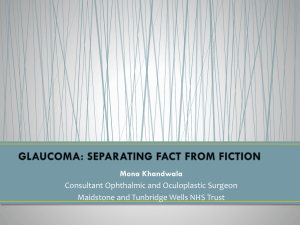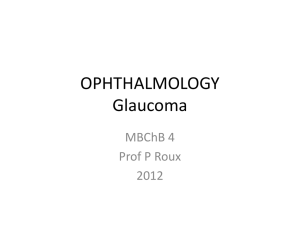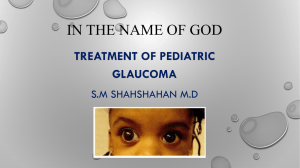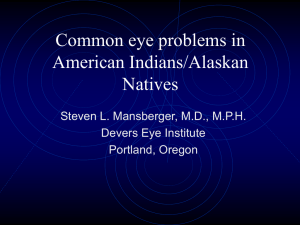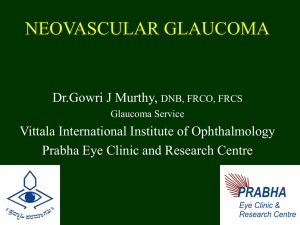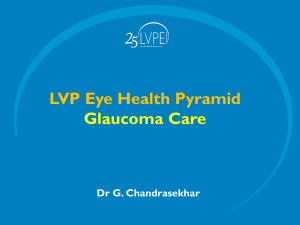Secondary Glaucoma
advertisement
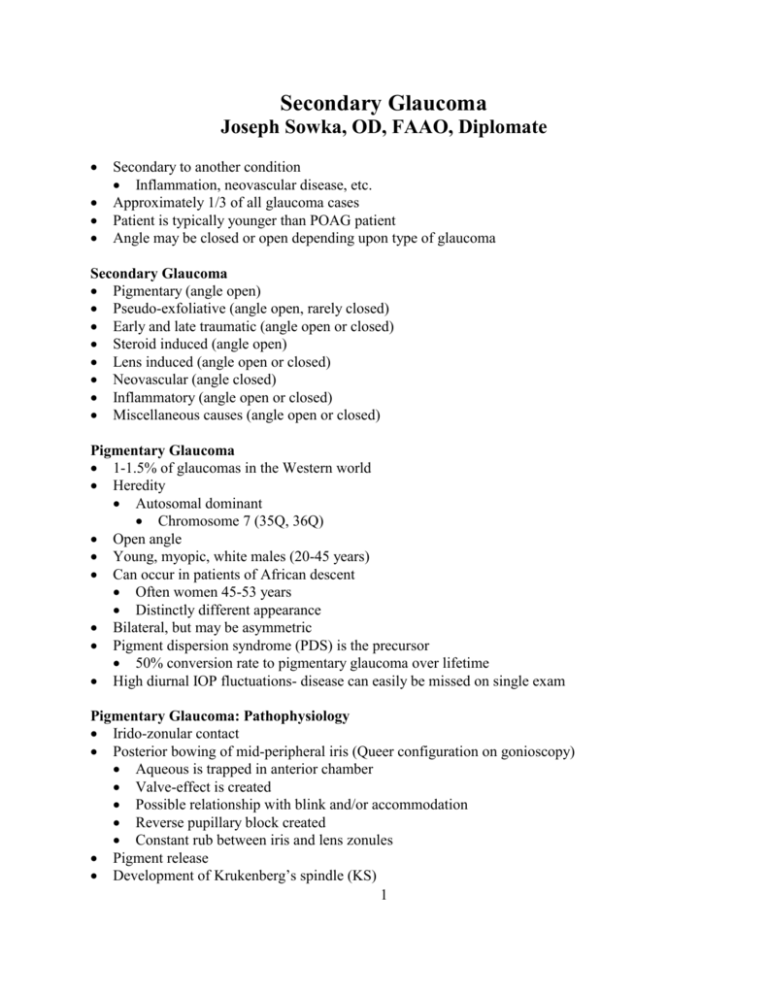
Secondary Glaucoma Joseph Sowka, OD, FAAO, Diplomate Secondary to another condition Inflammation, neovascular disease, etc. Approximately 1/3 of all glaucoma cases Patient is typically younger than POAG patient Angle may be closed or open depending upon type of glaucoma Secondary Glaucoma Pigmentary (angle open) Pseudo-exfoliative (angle open, rarely closed) Early and late traumatic (angle open or closed) Steroid induced (angle open) Lens induced (angle open or closed) Neovascular (angle closed) Inflammatory (angle open or closed) Miscellaneous causes (angle open or closed) Pigmentary Glaucoma 1-1.5% of glaucomas in the Western world Heredity Autosomal dominant Chromosome 7 (35Q, 36Q) Open angle Young, myopic, white males (20-45 years) Can occur in patients of African descent Often women 45-53 years Distinctly different appearance Bilateral, but may be asymmetric Pigment dispersion syndrome (PDS) is the precursor 50% conversion rate to pigmentary glaucoma over lifetime High diurnal IOP fluctuations- disease can easily be missed on single exam Pigmentary Glaucoma: Pathophysiology Irido-zonular contact Posterior bowing of mid-peripheral iris (Queer configuration on gonioscopy) Aqueous is trapped in anterior chamber Valve-effect is created Possible relationship with blink and/or accommodation Reverse pupillary block created Constant rub between iris and lens zonules Pigment release Development of Krukenberg’s spindle (KS) 1 Doesn’t always have to be a spindle formation The presence of Krukenberg’s spindle or endothelial pigment should lead you to transilluminate the eye. Transillumination defects (radially located in mid-peripheral iris) The presence of transillumination defects should lead you to perform gonioscopy Transillumination defects not always present Dependent upon iris thickness Not directly related to IOP Declines with age as the irido-zonular contact decreases as the eye ages and the lens status changes Relative pupil block raises iris off the zonules. Heavy pigment accumulation in trabecular meshwork Not directly related to IOP The TM endothelial cells phagocytize the pigment. Eventually, digested pigment as well as the increased activity breaks down the TM cells which lift off the trabecular beams. The overall result is a breakdown of the TM secondary to having to process the pigment. The subsequent inability to process aqueous causes IOP elevations. Physical blockade is only part of the reason for the pressure rise. Trabecular meshwork may have pigment deposition w/o IOP increase- depends on the ability of TM to process and phagocytize pigment Pigment release with dilation and exercise (anecdotal)- pts may have IOP spike after exercise Look for pigments in anterior chamber following dilation Pigment on lens equator – Scheie line: pathognomic for PDS/PG More common in Black patients Need wide dilation to see it Pigmentary Glaucoma: Presentation Endothelial pigment Transillumination defects Midperipheral and corresponding to zonular packets Trabecular meshwork pigment (seen on gonioscopy) Especially heavy inferiorly, due to gravity In some cases, there will be greater pigment superiorly than inferiorly. This is termed, “pigment reversal sign” and indicates a case of pigment dispersion that is “burning out” with trabecular processing returning to better activity. Backward bowed iris, especially in Caucasians (rare in patients of African descent) Iris has concave approach Pigment dispersion/ pigmentary glaucoma in African descent: Rare endothelial pigment No transillumination defects Heavy meshwork pigment Typically overlooked and considered “normal” in darkly pigmented patients Pigmentary Glaucoma: Management Treat PDS as a risk factor for glaucoma development. Initial fields, disc, and NFL analysis is indicated to assess what status of damage may have already occurred. Diagnosis can be 2 missed Tx similar to POAG Beta blockers, CAI, adrenergic agonist, prostaglandins There is an argument that because prostaglandins increase the size of the pigment cells, it may exacerbate the blockage. This concept is unproven, however and many patients have been successfully managed with these medications Pilocarpine 1% or Pilopine gel 4%HS (for younger pts.) However, the risk of retinal detachment in these patients on miotics is 6.6% While pilocarpine will stretch the iris, the risk of RD is there Patients the pigment dispersion syndrome/ pigmentary glaucoma have a higher incidence of retinal pathology such as lattice degeneration and retinal detachment Argon laser trabeculoplasty (ALT) or selective laser trabeculoplasty (SLT) Heavy pigment makes this treatment effective as laser is pigment dependent ALT success in pigmentary glaucoma: 80% @ 1 yr. 62% @ 2 yrs. 45% @ 3 yrs. Trabeculectomy For PDS- f/u Q3-6mos for IOP check. There is a significant diurnal IOP variation and you may miss change if you are cavalier. Perform DFE and fields There is new thinking that indicates that iridotomy may be indicated even though it is not a closed angle presentation because the iridotomy will lead to a shallowing of the anterior chamber, which may be enough to reduce irido-zonular apposition. There is theorized to be a reverse pupil block occurring whereas increased pressure occurs in the anterior chamber and forces the iris backwards into apposition with the lens zonules. Some feel that there is no effect on IOP, just a decreasing of the etiology, while others say that it takes at least 5 years in order to realize IOP lowering effect of this procedure. At this point, this manner of treatment is falling into disfavor. Clinical Pearl: There are many patients with pigment dispersion who do not develop glaucoma. However, be aware that there is a significant diurnal variation in IOP with PDS/PG and you must monitor PDS patients frequently. Clinical Pearl: Pigmentary glaucoma (and PDS) is different in Black patients. There may not be transillumination defects or endothelial pigment. In fact, this is often overlooked as a cause of glaucoma in Black patients. Pseudoexfoliative (PXE) Glaucoma Exfoliation: peeling of anterior lens capsule due to heat/radiation (glass blowers disease). This is truly rare. Pseudoexfoliation: age-related generalized disorder of the extracellular matrix characterized by the deposition of abnormal basement membrane (fibrillar extracellular material) on anterior lens capsule, iris, and in trabecular meshwork. Abnormal basement membrane comes from lens, iris, ciliary body, and uvea. In that true “exfoliation” is clinically very rare, 3 pseudoexfoliation syndrome and pseudoexfoliative glaucoma are often termed “exfoliation” This is the most common identifiable cause of open angle glaucoma worlwide Sixth to eighth decade Rare under age 40 3:1 bilateral, but may be asymmetric Unaffected “normal” eye will have subtle histopathologic changes Open angle High prevalence in northern Europeans Scandinavia, Ireland, USA Rare in patients of African descent Has only occurred rarely (some have said never) in Eskimos Peripupillary transillumination (may be seen in absence of clinically detectable pseudoexfoliative material) The presence or development of peripupillary TID is a very important indicator of PXE Pseudoexfoliative Glaucoma: Pathophysiology Exfoliative material Abnormal basement membrane Disturbed basement membrane metabolism Lens epithelium and other tissues as source Deposited on anterior lens capsule, not from lens Pigment released from pupil border Peripupillary transillumination defects – very important finding Heavy pigment (and exfoliative material) found in trabecular meshwork and may block trabecular meshwork, but the mechanism is not well understood Liberated pigment may cause blockage Material likely causes trabecular cell dysfunction Essentially functions the same as pigmentary glaucoma Lensectomy is not curative-material will deposit on IOL Now recognized as a generalized disorder of the extracellular matrix Exfoliation material is present in the walls of posterior ciliary arteries, vortex veins, and central retinal vessels as well as in the heart, lung, liver, kidney, gall bladder, and cerebral meninges Associated with central retinal vein occlusion (CRVO) Systemic associations include TIA’s, stroke, Alzheimer’s disease, hearing loss, hyperhomocysteinemia, and heart disease Polymorphisms in the coding region of the lysyl oxidase-like 1 (LOXL 1) gene on chromosome 15 are specifically associated with syndrome and glaucoma LOXYL 1 is a member of the lysyl oxidase family of enzymes, which are essential for the formation, stabilization, maintenance, and remodeling of elastic fibers and prevent agerelated loss of elasticity of tissues LOXYL 1 protein is a major component of the exfoliation deposits Pseudoexfoliative Glaucoma All tissues affected 4 Ocular HTN develops in 22-81% of pseudoexfoliative cases Overall, about 40% likelihood of developing glaucoma within 10 years When glaucoma develops, IOP is usually higher than in POAG More rapid progression than POAG IOP very labile Difficult to control More likely to need surgery More complications with cataract surgery Zonular dialysis, capsular rupture, and vitreous loss Loss of zonular support Can allow for angle closure as lens rocks forward Highest IOP is typically occurring outside normal office hours. IOP rise after dilation Pigment dispersion Pseudoexfoliative Glaucoma: Management Treat as POAG Beta blockers Prostaglandins Adrenergic agonists CAI’s ALT/ SLT - good modality Trabeculectomy Clinical Pearl: Pseudoexfoliative glaucoma is more severe than primary open angle glaucoma. More medications and surgery are needed to control pseudoexfoliative glaucoma than POAG. Pseudoexfoliative glaucoma is one of the worst glaucoma types to be encountered regularly in clinical practice. Clinical Pearl: Pseudoexfoliation is easily missed without a dilated lens evaluation. Clinical Pearl: Pigmentary glaucoma and pseudoexfoliative glaucoma may be within the spectrum of the same disease process. Clinical Pearl: The transillumination defects in pigmentary glaucoma are mid-peripheral and are peri-pupillary in pseudoexfoliation syndrome. Clinical Pearl: Pseudoexfoliation syndrome is now generally considered to be a widespread systemic condition of abnormal extracellular matrix that manifests most clearly in the eye. Traumatic Glaucoma Early and late effects Angle recession Hyphema 5 Inflammation Lens dislocations Perforation Early Traumatic Glaucoma Hours to days Inflammation Hyphema Trabecular meshwork changes Late Traumatic Changes Weeks to years Angle recession Peripheral anterior synechiae (PAS) Traumatic Glaucoma: Hyphema Tear in ciliary body (usually longitudinal muscle) Occurs within 7 days of injury Range from barely detectable to 8 ball hemorrhage Rebleed may occur within 5-7 days 50-90% of these pts. develop angle recession Prognosis based upon size of initial hemorrhage 1/3rd - good 2/3rd - fair > 2/3rd - poor IOP rise related to blood in anterior chamber, pupil block secondary to clot; hemolytic; sideritic; blockage by normal, ghost, or sickled red blood cells. Traumatic Glaucoma: Hyphema Management Bed rest (bathroom privileges only) Atropine 1% bid Pred forte q1h Aqueous suppressants Avoid prostaglandin analogs and miotics Avoid aspirin Sickle positive patients - 24/24 rule: If IOP > 24 mm hg for 24 hours, needs paracentisis Ghost Cell Glaucoma Follows traumatic hyphema or vitreous hemorrhage Ability of RBC's to traverse TM depends upon ability to bend Deformability is dependent on natural biconcave shape RBC’s undergo senescence in 120 days Hemoglobin leaches out and biconcave shape is lost (ghost of its former self) Trapped within TM-secondary open angle mechanism 6 Tx: paracentisis typically Traumatic Glaucoma: Angle Recession Cleavage of ciliary body muscles Widening and deepening of angle Fellow eye comparison is necessary because this is not obvious Problems occur years after antecedent trauma This should be your first thought when encountering unilateral glaucoma Etiology is thought to be trabecular meshwork scarring/sclerosis 10-20% angle recession pts. develop secondary glaucoma Severity of glaucoma related to extent of recession Traumatic Glaucoma: Angle Recession Management Observation if IOP, discs normal. Always remember that glaucoma can develop years later and these patients are forever at risk. Fair to poor response to medication Aqueous suppressants Beta blockers, CAI's, Alphagan Miotics very questionable due to changes in meshwork Prostaglandin analogs seem to work well LT very questionable- poor response if recession > 1800 Trabeculectomy works well POAG more common in fellow, uninjured eye. These patients may have predisposition to glaucoma Clinical Pearl: Always consider angle recession when encountering unilateral glaucoma. This is the number one cause of unilateral glaucoma. Clinical Pearl: When diagnosing angle recession, you must often compare gonioscopic appearance to the fellow eye, as angle recession can appear normal. Clinical Pearl: Approximately 40% of cases of angle recession glaucoma are made by imagination only when a doctor can find no other cause for a unilateral or asymmetric case of glaucoma. Traumatic Glaucoma: Penetrating Injuries Flat anterior chamber Synechiae (both posterior and anterior) Angle closure Metallic foreign body- siderosis Iron in the ferrous form is toxic to TM endothelium Fibrous connective tissue ingrowth Epithelial ingrowth Blocks TM 7 An ophthalmic train wreck (generally, there are no survivors) Manage with aqueous suppressants, surgery, etc., - Whatever works. Aggressiveness of management dictated by the level of remaining vision. Glaucoma management is secondary to management of open globe injury. Secondary Glaucoma: Steroid Induced Outflow difficulty- steroids are thought to change the TM ability to process aqueous. Glycoaminoglycan accumulation is though to be the underlying difficulty TM endothelium decreases phagocytotic ability Steroids may prevent release of enzymes that normally depolymerize gags Increased difficulty of outflow Topical or oral corticosteroids can cause IOP rise Ointment or creams periorbital and inhaled steroids can cause IOP increase May be seen in patients endogenously producing excess steroids (e.g., Cushing’s syndrome) 2 week onset (often longer) About 2/3 of population are steroid responders Response is dependent upon: Frequency of application Dose Genetic predisposition Genetic relationship - TIGR/Myocillin gene The incidence points to an autosomal recessive inheritance pattern Those at risk include: Myopes Pts with POAG Children Treatment: D/C meds After prolonged use, IOP may not lower with medication cessation Aqueous suppressants, Prostaglandins Trabeculoplasty poor; trabeculectomy better Steroid Response in Normal Patients: Dexamethasone 0.1% QID x 4-6 weeks Degree Low responders Moderate responders High responders Armaly & Becker 1970 Urban & Dryer 1990. Incidence 60-66% 30-33% 4-6% IOP response < 20 mm Hg 21-30 mm Hg > 30 mm Hg 8 Steroid Response in POAG Patients: Dexamethasone 0.1% QID x 4-6 weeks Degree Low responders Moderate responders High responders Armaly & Becker 1970 Incidence 6% 48% 46% IOP response < 20 mm Hg 21-30 mm Hg > 30 mm Hg Clinical Pearl: Steroid induced pressure elevations only occur in approximately 2/3rds of the population and it typically takes 2 weeks (minimum) to 5 weeks (typically) in order for IOP elevations to become apparent. Less than 10% of the population ever becomes a significant problem. Clinical Pearl: The patients most likely to steroid respond are those with glaucoma and children. Clinical Pearl: The most dramatic steroid responses that I have seen (both magnitude and rapid onset) have been in children. Secondary Glaucoma: Lens Induced Glaucoma Phacolytic Lens particle Phacoanaphylactic Phacomorphic Subluxated lens Lens Induced Glaucoma: Phacolytic Uveitis and elevated IOP in association with hypermature cataract Acute onset of pain and redness in an eye that is non-seeing Vision typically is in light perception range Hypermature cataract- lens leaks out internal proteins, which are antigenic. Capsule ruptures and extrudes lens proteins into anterior chamber Antigen/antibody reaction and subsequent A/C reaction Provokes macrophage response Heavy molecular weight proteins become soluble Proteins can leak out through an intact capsule Liquefaction of lens cortex and attenuation of lens capsule White flocculent material in chamber and on lens surface Bloated macrophages with lens material within them found in anterior chamber PMN’s, plasma cells, and lymphocytes are typically absent Variable anterior chamber reaction, heavy flare typical, hypopyon and KP’s rare If inflammation is bad enough, there can be posterior synechiae and pupil block with angle closure or angle closure without pupil block. Not likely, though Outflow blockage 9 Trabecular meshwork effects (open angle) Cured by lensectomy and vitrectomy Some surgeons have had success without vitrectomy Possibility of capsular rupture with subsequent vitrectomy required Medical therapy initially to temporize IOP and quell inflammation Corticosteroids q15min to Q2H, depending upon severity Cycloplegia (unless there is zonular damage and danger of subluxation): homatropine 5%, scopolamine ¼%, atropine 1% Beta blockers, alpha adrenergic agonists, CAI’s Avoid prostaglandins and miotics Clinical Pearl: Phacolytic glaucoma occurs more commonly than most practitioners realize. Always consider this in patients with advanced cataract, inflammation, and glaucoma. Lens Induced Glaucoma: Lens Particle Glaucoma Broken lens capsule (trauma/surgery) Essentially the same pathophysiology as phacolytic glaucoma, except that there is antecedent trauma rupturing the capsule rather than lens hypermaturity. Lens Induced Glaucoma: Phacoanaphylactic Uveitis Uveitis following cataract extraction Inflammatory secondary glaucoma Angle open or closed Autoimmunity to lens antigens, which may be left in anterior chamber following procedure. Essentially identical to uveitic glaucoma, but is associated with lensectomy complications. Occurs as a severe uveitis following cataract extraction- may be confused with endophthalmitis. Lens Induced Glaucoma: Phacomorphic Glaucoma Unilateral or asymmetric cataract associated with asymmetric shallowing of the anterior chamber not explained by other factors Difficult to differentiate from primary angle closure Acute to intermittent red, painful eye, typically at night Blurred vision from corneal edema Often have rapidly developing cataract from trauma or inflammation Mild anterior segment inflammation Typically, vision is greatly reduced (<20/400) Due to increasing lens thickness: irido-lenticular apposition from growth of the lens cortex and intumescence of the lens. May be associated with short globe axial length Occasionally, phacomorphic glaucoma will occur not due to mature cataract formation, but due to spherophakia in Weill-Marchesani syndrome Pupil block and posterior chamber pressure increase Secondary iris bombé 10 Angle closure with possible PAS formation Phacomorphic Glaucoma: Management Initial management should address the acute nature of the angle closure Beta blockers CAI’s Alpha 2 adrenergic agonists Pilocarpine 2% Corticosteroid Secondary management begins with iridotomy to relieve pupil block, and perhaps iridoplasty to retract iris out of angle Acceptable only if no significant PAS Be aware that angle closure can occur without pupil block and therefore, LPI is ineffective Optimal management is cataract extraction with IOL implantation LPI should be first performed as mydriasis for surgery can exacerbate the condition Cataract extraction in these patients has a high rate of exudative detachment of the choroid and ciliary body with rhegmatogenous retinal detachment. It is safer to do LPI and iridoplasty with medical therapy, especially if visual potential poor. Clinical Pearl: Consider phacomorphic glaucoma in cases with glaucoma, angle closure, shallow chamber, and asymmetric advanced cataract. Lens Induced Glaucoma: Ectopia Lentis Trauma Marfan's syndrome Pupil block with angle closure-may be reverse pupil block Complicated cataract extraction when lens is dislocated. Often better to leave it alone. Iridotomy to relieve angle closure and pupil block. Can have pupil block from other side if lens lies back against the pupil in the anterior chamber. Clinical Pearl: Any time the crystalline lens is displaced, there is the potential for pupil block and angle closure. Neovascular Glaucoma Neovascularization of the iris and angle (NVI/NVA) Many possible causes CRVO* Diabetic retinopathy* Carotid artery disease (ocular ischemic syndrome)* BRVO, HRVO CRAO Giant cell arteritis Coat’s disease 11 Eale’s disease Sickle cell retinopathy Uveitis Retinal detachment Ocular neoplasia *Most common causes Neovascular Glaucoma Pathophysiology Hypoxia from above conditions Vascular Endothelial Growth Factor – VEGF: Vasoproliferative angiogenic substance diffuses to viable tissue Neovascularization develops Rubeosis Angle neovascularization Vessels bridge scleral spur and arborize on trabecular meshwork Fibrovascular membranes Synechial closure of angle Tent-like PAS initially, later broad areas of angle closure Inflammation and high IOP Poor prognosis Poorly responsive to medical treatment 90 day glaucoma- usually occurs within 90 days of antecedent vascular occlusion This is unique in that the mechanism is secondary angle closure without pupil block Neovascular Glaucoma Management Medical tx: atropine and Pred forte used for inflammatory component. May also temporarily use aqueous suppressants. Generally, you do not medically treat this type of glaucoma. Trabeculectomy if not too much of the angle is compromised Pan-retinal photocoagulation (PRP) to destroy the ischemic retina and reduce the vasoproliferative substance and induce regression of neovascular vessels. Generally successful (90% success) in diabetic retinopathy if <270 degrees of closure. Much less successful in ocular ischemic syndrome. Cryotherapy may be used in place of PRP. A newer modality to manage refractory NVG involves trans-scleral diode laser cyclophotocoagulation. This reduces aqueous production through the laser-induced ablation of the ciliary processes. A still newer modality (used in conjunction with methods mentioned above) involves ocular injection of Avastin, an anti-vasogenic drug Overall poor prognosis- blind painless eye. Medically treating neovascular glaucoma is like arranging deck chairs on the Titanic Clinical Pearl: Neovascular glaucoma is typically the worst glaucoma that a patient can have. 12 Clinical Pearl: Always obtain an ESR and C-reactive protein on patients over the age of 60 years who have anterior segment neovascularization. Glaucoma Associated with Elevated Episcleral Venous Pressure Flow of aqueous: TM to Sclemm’s canal to aqueous veins to anterior ciliary veins to episcleral veins to superior and inferior ophthalmic veins to cavernous sinus to inferior petrosal sinus to jugular vein Increasing episcleral venous pressure will reflexly increase IOP Elevated episcleral venous pressure can be indirectly diagnosed gonioscopically by blood in Schlemm’s canal Possible causes: Carotid cavernous sinus fistula Low flow dural sinus fistula of the cavernous sinus Sturge-Webber syndrome Cavernous sinus thrombosis Retrobulbar tumors Thyroid ophthalmopathy Idiopathic elevated episcleral venous pressure Most glaucoma meds can only reduce gap between IOP and episcleral venous pressure and are thus very ineffective. Only one medication family will work independent of episcleral venous pressure: Prostaglandins Clinical Pearl: Whenever a patient comes in with a unilateral red eye and ipsilateral IOP elevation, always consider acute angle closure, uveitic glaucoma, and low-flow carotid cavernous sinus fistula. Clinical Pearl: Blood seen in Schlemm’s canal on gonioscopy should increase your suspicion for elevated episcleral venous pressure and lead you to use a prostaglandin medication. Clinical Pearl: You will always misdiagnose your first case of low-flow carotid cavernous sinus fistula. This statement applies also to neurologists, ophthalmologists, and primary care physicians. Uveitic Glaucoma Glaucoma secondary to uveitis may occur by one or by a combination of several different pathophysiological mechanisms. Careful delineation of the pathophysiology involved is the cornerstone of successful management. Clinical Appearance: Two Types "Hot" eye with pronounced episcleral injection, profuse anterior chamber reaction, high IOP, and variable patient discomfort (sometimes excruciating agony). 13 Quiet and insidious IOP elevation in patients with chronic iridocyclitis More likely to cause glaucoma Classifications and Mechanisms Angle closure with pupil block Angle closure without pupil block Open angle Combination involving all of the above Specific uveitic/ocular hypertensive syndromes Angle Closure with Pupil Block In acute anterior uveitis, there is a large amount of inflammatory cells, debris fibrous proteins, and aqueous proteins being released into the anterior chamber. Adhesions between the iris and the anterior lens face result in posterior synechiae leading to iris bombé. Posterior synechiae forms Posterior chamber pressure rises Iris bombé occurs Peripheral iris-meshwork apposition Peripheral anterior synechiae (PAS) Angle Closure without Pupil Block Deposition and subsequent contraction of inflammatory debris within the angle may pull the peripheral iris over the trabecular meshwork and cause a progressive closure by PAS. While this may occur without pupil block, there is often some degree of posterior synechiae present. Don’t be fooled. This is common and can happen even if the anterior chamber is deep. Open Angle Trabecular meshwork outflow can be impeded both by the accumulation of inflammatory cells as well as the inherent outflow infacility of proteinacious aqueous humor in patients with excessive flare. Flare may be more of a factor in the development of IOP elevation than the amount of inflammatory cells as outflow facility is greatly reduced in patients with excessive amounts of flare, irrespective of the number of inflammatory cells Increased protein content and increased aqueous viscosity. This, combined with other factors leads to a reduction in outflow through the trabecular meshwork Acute trabeculitis decreases processing ability Though unsubstantiated by histological evaluation, there may be direct inflammation of the trabecular meshwork itself (trabeculitis), leading to a decreased ability to filter aqueous Corticosteroids may also contribute to the IOP rise The pressure rise may or may not be proportional to the severity of the inflammation. Secretory hypotony (and increased uveoscleral outflow due to elevated levels of prostaglandins in the anterior chamber) may mask decreased trabecular function. Pressure spike may occur if ciliary aqueous function returns before trabecular function. 14 Clinical Pearl: In most cases of uveitic glaucoma, there will be a combination of factors causing pressure elevation. Glaucoma Associated with Acute Anterior Uveitis: Medical Therapy Aggressively reduce inflammation E.g. Pred forte (prednisolone acetate 1%) Q15min x 6H, then Q1H while awake May require steroid injections in very severe cases Can be handled topically if treatment begins early enough This is absolutely essential to prevent disaster. Do not worry about steroid response glaucoma. Under-treating inflammation due to concerns about steroid impact on pressure is false economy. Cycloplegia: Atropine 1% or scopolamine ¼% Prevent PAS with aggressive anti-inflammatory therapy above Break/prevent posterior synechiae In the early stage, prevent or break posterior synechiae with potent cycloplegics If this doesn't break synechiae, additionally use 10% Phenylephrine (Neosynephrine) in office. Pledgets of 10% neosynephrine in cul-de-sac Steroids help dissolve fibrin and adhesions Lower IOP 1. Beta-blockers, alpha-2 adrenergic agonists, and CAI's (topical or oral) 2. Avoid miotics -miotics exacerbate the condition because it causes movement to a damaged tissue, leading to further breakdown of the blood-aqueous barrier and an increase in inflammation and inflammatory cell in the anterior chamber. This can lead to disastrous consequences 3. Avoid prostaglandin analogs There will be high levels of prostaglandins already in the anterior chamber that mitigate the inflammatory reaction. May worsen condition, but more likely to not help rather than hurt Clinical Pearl: In cases of uveitic glaucoma, beta blockers tend to be less effective and topical CAIs tend to be more effective than in POAG. Glaucoma Associated with Acute Anterior Uveitis: Surgical Therapy For pupil block, reform communication between anterior and posterior chambers Multiple laser PI Surgical iridectomy if laser PI fails Effective only if less than 75% of angle compromised by PAS Trabeculectomy with antimetabolites and possible implant surgery Glaucoma Secondary to Chronic Iridocyclitis: IOP can easily vary by 10-30 mm Hg week to week Likely due to trabeculitis and not angle closure or inflammatory cell accumulation within 15 meshwork Patient not in pain but may have discomfort Vision may be variable due to increased inflammation and protein in the aqueous Biomicroscopic appreciation of changes in inflammation difficult Typically occurs when steroids are tapered or disease in not being well controlled Needs increased steroid dosage Clinical Pearl: The increased prevalence of glaucoma in chronic uveitis reflects the cumulative effects of inflammation and steroid use. In older patients, minimal amounts of inflammation may overcome a trabecular meshwork with declining function. In younger patients, severe inflammation is usually necessary to overcome a healthy, functional trabecular meshwork. Clinical Pearl: Glaucoma is more likely to occur with chronic uveitis rather than acute uveitis. Clinical Pearl: Regardless of the mechanism of pressure rise (i.e., angle status) in uveitic glaucoma, the treatment is essentially the same: Aggressive use of steroids, cycloplegics, mydriatic agents, and aqueous suppressants. Avoid prostaglandins and miotics. Hypertensive Uveitis Syndromes: Glaucomatocyclitic Crisis Posner-Schlossman Syndrome Idiopathic and idiosyncratic Ocular hypertensive syndrome associated with mild AC reaction Occurs mostly between ages of 20 and 60 years, and is rare over age 60 Unilateral Recurrent Intervals of months to years Mild symptoms, or may be asymptomatic Blurred vision secondary to corneal edema common Mild anterior chamber reaction Keratic precipitates are often the only sign of inflammation, and may not even be present Flat, round, and non-pigmented Concentrated over inferior endothelium usually The conjunctiva may be white and quiet, or mildly injected Anterior chamber angle is open and normally pigmented Pupil may be mid-dilated Iris hypochromia may occur, but is uncommon High IOP (30mm hg-60mm hg is typical, but 90 mm Hg has been reported) IOP elevation can precede inflammation signs IOP level is disproportional to amount of inflammation Self limiting Duration: hours to weeks- typically will last for several days, but can persist for months Normal fields and discs in many cases, but damage can occur over time 16 There is a strong association with POAG in these patients All findings normal between attacks Glaucomatocyclitic Crisis: Pathophysiology An obscure etiology. Decreased outflow suggests a trabeculitis as the causative mechanism. Prostaglandin E (causing a breakdown of the blood-aqueous barrier) found in high concentrations, which may increase the blood-aqueous barrier permeability and lead to increased aqueous production. Also, prostaglandins will lead to an increase in cells and proteins in the AC due to the barrier breakdown. Prostaglandin E has been found in high levels during acute attacks and normal levels have been found in the same patients during normal times. There has been evidence of the herpes virus in the anterior chambers of patients with glaucomatocyclitic crisis Clinical Pearl: There is something unique about the Herpes virus that causes trabeculitis. Glaucomatocyclitic Crisis: Treatment This is self-limiting and will spontaneously resolve. If you are sure of the diagnosis, the patient can potentially be monitored without medical treatment. If you decide to treat (especially if IOP is very elevated), direct treatment at the inflammation first and the ocular hypertension secondarily. Avoid miotics and prostaglandin analogs. Cease treatment between attacks, but monitor closely between attacks as there is a high incidence of concomitant POAG in these patients. These patients may develop POAG or they may spend more time in attacks than normal and this will lead to permanent damage. Corticosteroids are treatment of choice Cycloplegics/mydriatics are generally unnecessary Beta blockers, alpha adrenergic agonists, CAI’s Clinical Pearl: Glaucomatocyclitic crisis is frequently misdiagnosed. condition in cases of mildly symptomatic red eye with elevated IOP. Consider this Clinical Pearl: When trying to diagnose Glaucomatocyclitic crisis: Look carefully in the anterior chamber for a rare cell or two, and check the endothelium for any keratic precipitates. Clinical Pearls: The highest pressures that I have ever encountered have been in patients with inflammatory conditions. Fuch’s Heterochromic Iridocyclitis Diagnosis usually made between ages 30 and 60, but ranges from teens to 70’s Most missed cause of uveitis Triad: heterochromia, iridocyclitis, and cataract 17 Heterochromia may be absent or subtle Chronic anterior chamber reaction Keratic precipitates distributed over entire endothelium (characteristic of this condition) Synechiae are atypical and do not contribute to glaucoma due to small size Cataract present in most patients, but occur later and do not help in diagnosing early cases Chorioretinal lesions reminiscent of toxoplasmosis occur frequently 60% of Fuch’s patients with chorioretinal scarring had positive toxo titres Glaucoma is the main cause of vision loss in Fuch’s patients Etiology is unknown, but believed to be due to chronic trabecular inflammation leading to sclerosis Unless glaucoma develops, no treatment is necessary Steroids don’t work Treat as POAG Clinical Pearl: Consider Fuch’s heterochromic iridocyclitis in cases of uveitis that doesn’t respond to steroids, glaucoma, and cataract, especially in younger patients. Clinical Pearl: The systemic disease that I have found most associated with uveitic glaucoma is herpes zoster. Conversely, the most common ocular manifestation of herpes zoster that I have encountered is uveitic glaucoma. In these cases, the IOP was disproportionate to the severity of the uveitis. As the herpes virus has been isolated in the aqueous of patients with glaucomatocylitic crisis, there is evidence that there is something unique to the herpes virus in its ability to produce a profound trabeculitis. Clinical Pearl: GLAUCOMA! NEVER USE MIOTICS TO LOWER IOP IN CASES OF UVEITIC Clinical Pearl: Avoid prostaglandins in cases of uveitic glaucoma. 18


